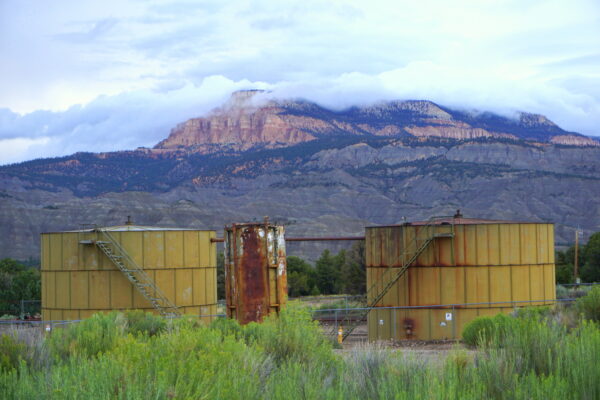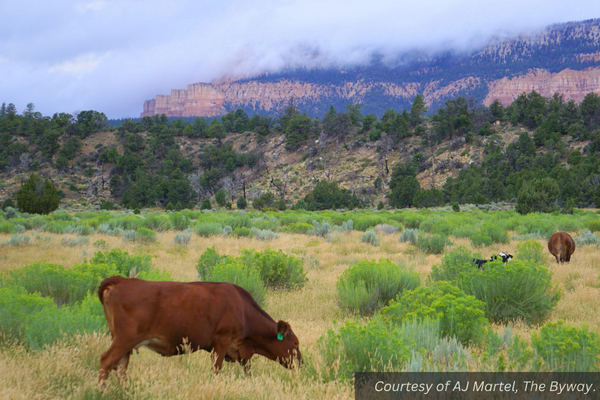“Ranching for Generations” is part 7 in an 8-part series focused on explaining a document called “A Manifesto for Local Stewardship.” The manifesto, which made its rounds in summer of 2022, was published in The Byway’s most recent September paper.
Between 1945 and 1947, over seven million American soldiers returned home from WWII to look for jobs. For many from the West, they returned home and found those jobs in ranching, farming, mining or timber cutting — most of which was on land managed by the federal government.
One of these young men had grown up on the family farm in western Utah. During the war, he had learned diesel mechanics and was able to bring home his training after his discharge. He converted his father’s farm machinery into diesels and helped save the family money, as diesel fuel was much cheaper than gas at that time.
He then bought cattle permits for a grazing allotment in the vast basin-and-range territory of Utah’s West Desert. There, he took his tractor up on the range to clear and reseed the ground. He spent the entire summer on this project working long hours and hard days preparing the land. At the end of the season, he and his brothers burned the slash piles and in the following spring they reseeded the land, creating a grazing area that still exists today.
Also at the end of WWII, President Harry S. Truman organized the Bureau of Land Management in 1946 through the merger of the General Land Office and the United States Grazing Service. The Grazing Service had been established as part of the Taylor Grazing Act in 1934 to formalize the use of lands that in many cases had been actively grazed for decades already.
In the early 20th century, Congress took steps toward recognizing the value of the assets on public lands and directed the executive branch to manage activities on the remaining lands not privatized through The Homestead Act of 1862. Beside grazing activities, the Mineral Leasing Act of 1920 allowed leasing, exploration and production of selected commodities.
The Taylor Grazing Act of 1934 established the United States Grazing Service to manage public rangelands by establishment of advisory boards that set grazing fees. Then in 1946 they were combined to create the Bureau of Land Management (BLM).
Today, overseen by the Department of the Interior, the BLM manages 245 million acres across the United States of America, mostly west of the Continental Divide.
The agency also manages 700 million acres of subsurface mineral estate located beneath federal, state and private lands that were severed from their surface rights by the Homestead Act. Today, ranchers hold nearly 18,000 permits and leases for livestock grazing on 155 million acres of public lands.
The same grazing allotment our diesel mechanic veteran cleared and seeded in the 1950s is still grazed today by the same family. Imagine 70 years of grazing on the same land — and that doesn’t include grazing prior to the 1950s. That is an example of sustainable agriculture.
In many years, this family of 6th-generation ranchers chooses to only graze half of the number of cows allotted because of conditions such as drought. Some years if the ground is too wet, they remove the cattle early to save the roads and plants. None of this is required under the terms and conditions of the grazing permit, but is practiced in wisdom from years of learning.
Beside the allotment’s grazing value for cattle, the family states that the allotment provides feed for wildlife. A spring that the family improved at their own cost also provides wild game a trough to drink from. On dry years, the family hauls water from town to these troughs placed on the allotment.
This family’s grazing story is not an unusual story. Many other ranchers and farmers throughout the West conduct themselves in a similar manner, going above-and-beyond the federal requirements in order to maintain a healthy allotment that will sustain its productivity for years to come.
Bishop Gérald Caussé summed up the religious sentiment of many of these land users: “These wonderful creations were prepared entirely for our benefit and are living proof of the love the Creator has for His children,” he said.
Governed by faith in God, ranchers and farmers know their use of the Earth also comes with responsibility — and man’s duty to the Earth is described as stewardship.
Bishop Caussé explained that this stewardship rests on three principles — that first, the entire earth belongs to God. Second, as stewards of God’s creations, we have a duty to honor and care for them; and third, we are invited to participate in the work of creation.
Caussé added, “Similarly our role as stewards of earthly creations is not solely about conserving or preserving them. The Lord expects us to work diligently, as moved upon by His Holy Spirit, to grow, enhance and improve upon the resources He has entrusted to us—not for our benefit only but to bless others.”
I believe that the farmer and rancher fulfill this role better than most in this life. They care for the land which they automatically conserve because it is in their best interest to be able to farm or graze that land for 70 years and more. They cannot spoil what they would like to pass on to their sons and daughters. They leave a legacy of caring for the land and its creatures.
The Earth and its bounty are great gifts from God, and certainly are worth taking care of. Because we are given much more than we could ever earn through our own efforts, we should not be overcome with guilt, but rather, gratitude for the gift.
“For the earth is full, and there is enough and to spare,” Doctrine and Covenants 104:17 reads. We salute the farmers and ranchers who have for decades preserved our western lands that we may have and use them to enjoy the Earth’s great bounty.
– by Elaine Baldwin

Feature image caption: Cows graze on a Dixie National Forest allotment at the west end of Upper Valley north of Henrieville, August 21, 2023. Grazing is just one of several authorized uses of federal land and is protected by Congress under the multiple-use mandate.
Elaine Baldwin – Panguitch
Elaine Baldwin is an Editor/Writer for The Byway. She is the wife of Dale Baldwin, and they have three children, 11 grandchildren and one great granddaughter. Elaine enjoys making a difference in her world. She recently retired after teaching Drama for 20 years at Panguitch High School. She loves volunteering and finds her greatest joy serving in the Cedar City Temple each Friday.

